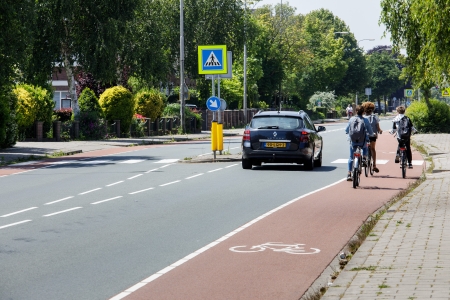Several measures have contributed to the improvement of road safety in general and thus to children’s road safety. These are combined measures in the field of infrastructure, vehicles, means of protection and education.
Infrastructure
Examples of infrastructural measures are the increase of the number of 30km/h zones; the more frequent physical separation of fast and slow traffic; more roundabouts; and the redirection of mopeds to the carriageway. These aspects of the Dutch programme Sustainable Safety are relevant to all cyclists and pedestrians and, thus, to all walking and cycling children [29] [30] [31] [32].
Vehicle safety
Cars have become safer for their occupants and, thus, for child passengers. In addition, car fronts have become safer, so that collisions with pedestrians and cyclists have less serious outcomes. At the end of 2003, EU regulations took effect, in particular concerning the protection of pedestrians. In the EU, view-enhancement systems have become mandatory for lorries; these include blind spot mirrors and cameras. These kinds of provisions reduce the number of crashes involving right-turning lorries and cyclists. For more information see SWOV fact sheet Safe passenger cars.
Protection measures
The protection of children in cars has been improved since the use of (ever improving) child restraint seats became customary. In the Netherlands, the use of EU approved child restraint seats in cars has become mandatory for children up to 135 cm in height. In 2013, the new EU directive called ‘i-Size’ took effect (ECE-R129). This directive lays down that every type of child restraint seat must have passed an impact test prior to approval; that child restraint seats must be categorised according to body height; and that children up to 15 months old must be transported in rear-facing seats. Since 2004, bicycle child seats have also been subject to European safety standards.
Education
In the field of traffic education, a lot of initiatives have been taken, not only in formal school education, but also in informal education by parents. Parents play an important role in sharing knowledge and teaching skills that allow their children to become safe road users [21]. Although education is important to adequately equip children for traffic participation, not much is known about its crash risk effects (also see SWOV fact sheet Traffic education and the question How does traffic education and practice affect children’s road safety?).
